🔗Asymptote Gallery Tagged by “Clip” #81
🔗geometry-fig028
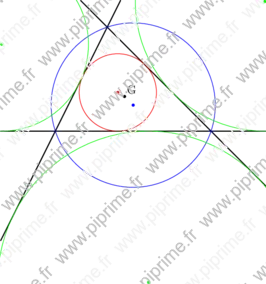
Show geometry/fig0280.asy on Github.
Generated with Asymptote 3.00-0.
Categories : Examples 2D | Geometry.asy
Tags : #Geometry | #Point | #Clip | #Circle
import geometry; size(10cm); // currentcoordsys=cartesiansystem((2,1),i=(1,0.5),j=(-0.25,0.75)); // show(currentcoordsys); point A=(-1,0), B=(2,0), C=(0,2); draw(line(A,B), linewidth(bp)); draw(line(A,C), linewidth(bp)); draw(line(B,C), linewidth(bp)); /*<asyxml><view file="modules/geometry.asy" type="circle" signature="circle(point,point,point)"/></asyxml>*/ circle cc=circle(A,B,C); draw(cc, blue); dot(cc.C, blue); /*<asyxml><view file="modules/geometry.asy" type="circle" signature="incircle(point,point,point)"/></asyxml>*/ circle ic=incircle(A,B,C); draw(ic, red); dot(ic.C, red); /*<asyxml><view file="modules/geometry.asy" type="circle" signature="excircle(point,point,point)"/></asyxml>*/ circle ec=excircle(A,B,C); /*<asyxml><view file="modules/geometry.asy" type="void" signature="clipdraw(picture,Label,path,align,pen,arrowbar,arrowbar,real,real,Label,marker)"/></asyxml>*/ clipdraw(ec, green); dot(ec.C, green); ec=excircle(A,C,B); clipdraw(ec, green); dot(ec.C, green); ec=excircle(C,B,A); clipdraw(ec, green); dot(ec.C, green); dot("G",centroid(A,B,C),NE); // Enlarge the bounding box of the current picture // draw(box((-2.5,-3), (3.5,3.5)));
🔗geometry-fig033
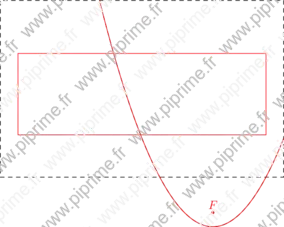
Show geometry/fig0330.asy on Github.
Generated with Asymptote 3.00-0.
Categories : Examples 2D | Geometry.asy
Tags : #Geometry | #Draw (2D) | #Clip | #Deferred drawing | #Parabola
import geometry; size(10cm); point F=(2,-1.5); dot("$F$",F,N,red); // Enlarge the bounding box of the current picture. draw(box((-1,-1),(3,1.5)),dashed);//,invisible); parabola p=parabola(F,0.2,90); // Define the bounding box to draw the parabola. // Try finalbounds(); to determine the final bounding box. p.bmin=(-0.75,-0.4); p.bmax=(2.75,0.75); draw(box(p.bmin,p.bmax),red); draw(p,dashed);/* Defered drawing to adjust the path to the final bounding box.*/ draw((path)p,red); /* The path of 'p' is restricted to the box whose the corners are p.bmin, p.bmax.*/
🔗geometry-fig034
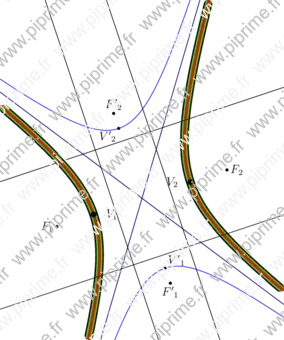
Show geometry/fig0340.asy on Github.
Generated with Asymptote 3.00-0.
Categories : Examples 2D | Geometry.asy
Tags : #Geometry | #Draw (2D) | #Clip | #Deferred drawing | #Hyperbola | #Line
import geometry; size(10cm,0); // currentcoordsys=cartesiansystem((2,1),i=(1,0.5),j=(-0.25,.75)); // show(currentcoordsys); point F1=(1,0); point F2=(4,1); dot("$F_1$",F1,W); dot("$F_2$",F2); // Enlarge the bounding box of the current picture draw(box((0,-2), (5,4)), invisible); /*<asyxml><view file="modules/geometry.asy" type="hyperbola" signature="hyperbola(point,point,real,bool)"/></asyxml>*/ hyperbola h=hyperbola(F1, F2, 0.9); draw(h, linewidth(3mm)); draw(h.A1, grey); draw(h.A2, grey); draw(h.D1); draw(h.D2); /*<asyxml><view file="modules/geometry.asy" type="hyperbola" signature="hyperbola(point,real,real,real)"/></asyxml>*/ draw(hyperbola(h.C, h.a, h.b, h.angle), 2mm+green); /*<asyxml><view file="modules/geometry.asy" type="hyperbola" signature="hyperbola(bqe)"/></asyxml>*/ draw(hyperbola(equation(h)), 1mm+red); /*<asyxml><view file="modules/geometry.asy" type="hyperbola" signature="conj(hyperbola)"/></asyxml>*/ hyperbola ch=conj(h); draw(ch, blue); draw(ch.A1, 0.5blue); draw(ch.A2, 0.5blue); draw(ch.D1); draw(ch.D2); dot("${V'}_1$", ch.V1, NE); dot("${V'}_2$", ch.V2, SW); dot("${F'}_1$", ch.F1, S); dot("${F'}_2$", ch.F2, N); dot("$V_1$", h.V1, 2E, linewidth(2mm)); dot("$V_2$", h.V2, 2W, linewidth(2mm));
🔗tiling-fig002
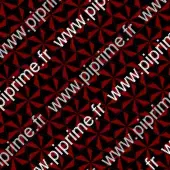
Show tiling/fig0020.asy on Github.
Generated with Asymptote 3.00-0.
Categories : Surveys | Tiling
Tags : #Tiling | #Clip
size(6cm,0); //Circular paving with the unit hexagonal picture "hexa" picture pavehexagonal(picture hexa, int depth=1) { picture opic; pair center; real a,ap,r,rp,r_d=180/pi; add(opic, hexa); for(int j=0; j<depth; ++j) { for (int i=1; i<=6; ++i) { a=i*60-30; r=j*sqrt(3); center=r*(rotate(a)*(1,0)); add(opic, shift(center)*hexa); rp=r; ap=0; for (real k=0; k<j-1; ++k) { r=sqrt((1.5*(j-1 - k))^2 + 3/4*(j+1 + k)^2); ap+=r_d*acos((rp^2 + r^2 - 3)/(2*r*rp)); center=r*(rotate(a + ap)*(1,0)); add(opic, shift(center)*hexa); rp=r; } } } return opic; } picture hexa; fill(hexa, polygon(6)); path inh=(0,0)--(.6,sqrt(3)/4)--(.5,sqrt(3)/2)--cycle; for(int i=0; i<6; ++i) { fill(hexa, rotate(60*i)*inh,.5red); } draw(hexa, inh); add(rotate(45)*pavehexagonal(hexa,10)); clip(scale(10)*shift(-.5,-.5)*unitsquare);
🔗tiling-fig006
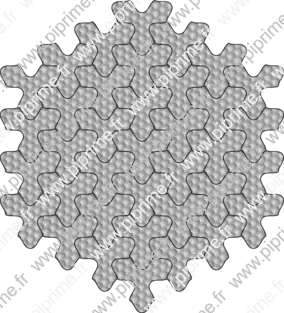
Show tiling/fig0060.asy on Github.
Generated with Asymptote 3.00-0.
Categories : Surveys | Tiling
Tags : #Tiling | #Clip
size(10cm,0); transform r60=rotate(60); pair A=(1,0); pair B=r60*A, C=r60*B, D=r60*C, E=r60*D, F=r60*E; real ad=30; real tensio=.25; path AB=A {dir(120-ad)} .. shift(tensio*dir(30))*midpoint(A--B) .. B {dir(120+ad)}; path BC=reverse(rotate(240,B)*AB); path CD=reverse(rotate(240,C)*BC); path DE=reverse(rotate(240,D)*CD); path EF=reverse(rotate(240,E)*DE); path FA=reverse(rotate(240,F)*EF); path pth1=AB--BC--CD--DE--EF--FA; real tensio=.5; path AB=A {dir(120-ad)} .. shift(tensio*dir(30))*midpoint(A--B) .. B {dir(120+ad)}; path BC=reverse(rotate(240,B)*AB); path CD=reverse(rotate(240,C)*BC); path DE=reverse(rotate(240,D)*CD); path EF=reverse(rotate(240,E)*DE); path FA=reverse(rotate(240,F)*EF); path pth2=AB--BC--CD--DE--EF--FA; //Circular paving with the unit hexagonal picture "hexa" picture pavehexagonal(picture hexa, int depth=1) { picture opic; pair center; real a,ap,r,rp,r_d=180/pi; add(opic, hexa); for(int j=0; j<depth; ++j) { for (int i=1; i<=6; ++i) { a=i*60-30; r=j*sqrt(3); center=r*(rotate(a)*(1,0)); add(opic, shift(center)*hexa); rp=r; ap=0; for (real k=0; k<j-1; ++k) { r=sqrt((1.5*(j-1 - k))^2 + 3/4*(j+1 + k)^2); ap+=r_d*acos((rp^2 + r^2 - 3)/(2*r*rp)); center=r*(rotate(a + ap)*(1,0)); add(opic, shift(center)*hexa); rp=r; } } } return opic; } picture hexa, hexat; real lux=-.3, sq=sqrt(3); radialshade(hexa,pth1--cycle, lightgrey,(lux*sq/2,lux/2),0, grey,(lux*sq/2,lux/2),1+abs(lux)); add(hexat,scale(1/(3*sq))*pavehexagonal(hexa,5)); clip(hexat,pth2--cycle); draw(hexat,pth2); add(pavehexagonal(hexat,4));